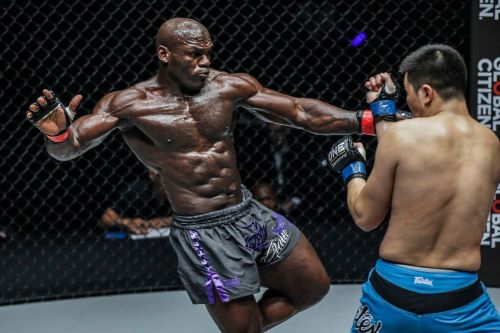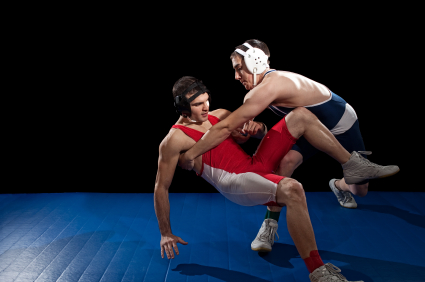What Muscles are Important for Wrestling
The most important muscles for wrestling are the ones in the legs and hips. These muscles help with explosiveness, speed, and agility; all of which are key when wrestling. The quads, hamstrings, and glutes are some of the most important muscles for wrestlers.
Strong abs and a strong back are also important, as they help with taking down an opponent and avoiding being taken down.
What Muscles Are Worked Out in Arm Wrestling? : Martial Arts Training
There are a lot of muscles that are important for wrestling. The most important muscle groups for wrestling are the legs, back, and shoulders.
The legs are important for two reasons.
First, they generate the power needed to take an opponent down. Second, they provide the stability needed to maintain control during a match.
The back is important because it provides the strength needed to lift an opponent off the ground and throw them around.
It also helps to protect the spine from injury.
The shoulders are important because they help to create leverage when pinning an opponent or throwing them around. They also help to protect the head and neck from being injured during a match.
Importance of Strength in Wrestling
As a wrestler, you know that strength is important. After all, wrestling is a physical sport and the stronger you are, the better your chances of winning. But what you may not realize is just how important strength is in wrestling.
Sure, having brute force can give you an advantage when it comes to takedowns and pins, but there’s more to it than that. Strength plays a big role in your overall stamina, which means it can help you keep going when things get tough in a match. It also gives you the power to break out of an opponent’s hold, or even reverse it altogether.
Of course, developing strength takes time and dedication. You can’t just expect to become strong overnight – it takes months (or even years) of hard work in the gym. But trust us, it’ll be worth it when you step on the mat and feel confident knowing that your superior strength will give you an edge over your opponent.
Why is Flexibility Important in Wrestling
Wrestling is a demanding sport that requires explosive power, speed, and agility. It also requires a high degree of flexibility in order to perform the various moves associated with the sport. The reason flexibility is so important in wrestling is that it allows wrestlers to execute the many different moves required to win a match.
Without flexibility, it would be very difficult, if not impossible, to perform many of the necessary maneuvers. Some of the most important benefits of flexibility include improved range of motion, increased power and force production, reduced risk of injury, and enhanced recovery from training sessions. By increasing your range of motion, you’ll be able to move more freely and effectively execute all the different wrestling moves.
This will lead to increased power and force production as well as reduced injuries. Finally, being more flexible will help your body recover faster from tough workouts or matches. If you want to improve your wrestling performance, you must focus on increasing your flexibility.
There are a variety of ways you can do this including static stretching, dynamic stretching, foam rolling, and using resistance bands. Try incorporating these techniques into your warm-ups and cool-downs on a daily basis and you’ll soon see an improvement in your flexibility levels.
What Muscles are Used in Arm Wrestling
When it comes to arm wrestling, a few key muscles come into play. The main muscle groups used in arm wrestling are the biceps, triceps, and forearm muscles. The biceps are responsible for flexing the elbow joint, which is crucial for generating the power needed to win an arm wrestling match.
The triceps extend the elbow joint, which helps to keep your opponent’s arm from moving. And finally, the forearm muscles help to grip your opponent’s hand and provide stability during the match. So if you’re looking to improve your arm wrestling game, be sure to focus on strengthening these key muscle groups!
What Do Wrestlers Need
Wrestlers need to be physically fit and have a lot of endurance. They also need to be able to think strategically and be quick on their feet. Most importantly, they need to have heart and determination.
How Much Does Strength Matter in Wrestling
It’s no secret that wrestling is a physically demanding sport. To be successful, wrestlers must be in the excellent physical condition and possess a great deal of strength. But how much does strength actually matter in wrestling?
While there is no doubt that being strong gives wrestlers an advantage, there are many other factors that are more important than raw strength. For example, technique, speed, and stamina are all critical elements of success in wrestling. That’s not to say that strength isn’t important at all.
Being strong can help wrestlers control their opponents and make it easier to execute certain moves. However, relying too much on brute force can often lead to mistakes and missed opportunities. In the end, while being strong definitely has its benefits, it’s far from the most important quality for a successful wrestler.
There are many other factors that contribute far more to success in this demanding sport.

Credit: strongerwrestler.com
What are the Most Important Muscles for Wrestling?
While there are many muscles that are important for wrestling, the most important muscle group is the legs. The quads, hamstrings, and glutes work together to provide the power needed to take down an opponent. Strong legs also help to control an opponent on the mat and can make it difficult for them to escape from a hold.
The core is also very important for wrestlers. A strong core helps maintain balance and stability while wrestling and can also generate a lot of power when throwing an opponent. The abs, obliques, and lower back all work together to keep a wrestler stable and powerful.
The arms are also used a lot in wrestling. While they don’t generate as much power as the legs, they are still used for takedowns, throws, and controlling an opponent on the mat. The biceps, triceps, and forearms all need to be strong in order for a wrestler to be successful.
What Muscles Should I Train for Wrestling?
If you’re interested in wrestling, you’ll need to focus on developing strength, speed, and agility. To build the necessary muscles for wrestling, you should include exercises that work your legs, back, chest, shoulders, and arms.
Some specific exercises that can help you build muscle for wrestling include squats, deadlifts, bench presses, military presses, rows, and pull-ups.
These compound exercises will help you develop the overall strength you need for wrestling.
In addition to compound exercises, you should also focus on explosive movements to improve your power and speed. Exercises like sprints, jump squats, and medicine ball throws can all be beneficial for wrestlers.
Finally, don’t forget about working on your cardiovascular fitness. Wrestling is an intense sport that requires a high level of endurance. Running or biking are great ways to improve your cardio endurance.
By including a mix of different types of workouts in your training routine, you can develop the muscles needed to be successful in wrestling.
Does Muscle Matter in Wrestling?
While there are many different types of wrestling, the short answer to this question is yes – muscle does matter in wrestling. Of course, not all wrestlers are created equal and there are a variety of techniques that can be used to gain an advantage over an opponent, but in general, bigger and stronger wrestlers will have a significant advantage over those who are smaller and weaker. There are a few reasons for this.
First, wrestling is a very physically demanding sport. It requires a lot of strength and endurance to be successful. Second, wrestling is also a very technical sport.
There are a lot of small details that can make a big difference in how successful someone is. This means that wrestlers who have more experience and/or better technique will often be able to overcome opponents who may be physically stronger than them. That said, there are definitely some weight classes where being bigger and stronger gives you a big advantage.
For example, in heavyweight wrestling, it is tough for a smaller wrestler to compete against someone who outweighs them by 100 pounds or more. In these cases, size really does matter. So if you’re thinking about taking up wrestling, don’t worry if you’re not the biggest or strongest person out there – you can still be successful with the right training and effort.
But if you’re looking to dominate your opponents, then building up some muscle mass might just give you the edge you need!
What Muscles are Most Important for Arm Wrestles?
When it comes to arm wrestling, the muscles most important for success are those in the forearm and upper arm. The forearm is responsible for gripping the opponent’s hand, while the upper arm provides the power to push the hand down. To develop these muscles, forearm and upper arm exercises such as curls and triceps extensions should be included in your training routine.
However, grip strength is also important for arm wrestling, so exercises that focus on developing this quality are also beneficial. These can include grip-specific exercises like farmer’s walks and gripping a tennis ball.
Conclusion
Wrestling is a physically demanding sport that requires a high level of strength, power, and endurance. The muscles used most during wrestling are the legs, back, and shoulders. The leg muscles are responsible for explosive movements, while the back and shoulder muscles provide stability and support.
To be successful in wrestling, it is important to have a strong foundation in all three muscle groups.


